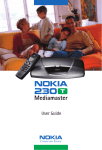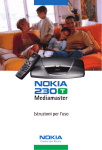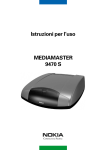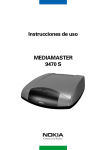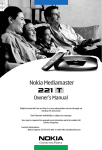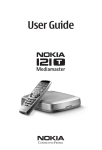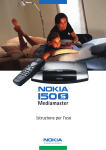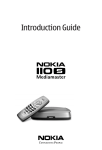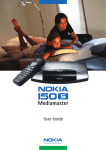Download Nokia 150T User's Manual
Transcript
User Guide Quick Guide Preparing the Remote Control Connecting a TV and a video recorder RF video SCART 2 1 3 Switching on for the first time • Plug in your Mediamaster. • The “First time installation”menu is shown. • Press the select button on the remote control to start the installation procedure. Language • Select the desired menu language with cursor up /down. (Cursor = see page 9.) This will also be the default language for audio and subtitling. • Press select again to confirm your language choice and to start searching for TV/radio channels. Channel search in progress This menu will be shown while the Mediamaster is searching for TV and radio channels. All channels found will be listed on the screen. Please note that the search procedure may take a few minutes. You may cancel the search at any time by pressing select. When Mediamaster is done searching, the number of TV and radio channels found will be displayed. • Press select to continue. GB 3 Quick Guide Time adjustment Select cursor up/down to adjust the time in half-hour increments. To adjust the minutes, select cursor left/right . • Press select to finish the installation and to open the Navi Bars. GB 4 Contents Quick Guide 3 Switching on for the first time Language Channel search in progress Time adjustment 3 3 3 4 End user license Security information Remote control Front and rear panel Connecting the Mediamaster 6-7 8 9 10 11 About the SCART sockets Preparing the remote control About the digital transmission Connecting to the TV aerial General Connecting the Mediamaster to the TV Connection of a video recorder Connecting a satellite receiver and a video Connecting a HiFi system Procedure when RF connections are used First time installation 11 11 11 11 12 12 13 13 13 14 Control folder ☛ User prefs Control folder ☛ Edit channels Control folder ☛ Timer Control folder ☛ System info Settings folder ☛ Channel Settings folder ☛ TV Settings folder ☛ Access Settings folder ☛ Time Settings folder ☛ SW update Settings folder ☛ Reinstall Viewing mode General Information Programme information Extended programme information Temporary settings TV Release (0) Teletext Glossary Troubleshooting Technical specifications 18 19 22 22 23 24 25 25 26 26 27 27 27 28 28 29 29 30 31 32 15 General information Switching on for the first time and start the “First time installation” Language Time adjustment Channel search in progress Navi Bars 15 15 15 16 16 17 General information The “Control” and “Settings” folders 17 18 Nokia, Nokia Connecting People and Navi Bars are registered trademarks of Nokia Corporation. Other product and company names mentioned herein may be trademarks or trade names of their owners. Nokia operates a policy of continuous development. Therefore we reserve the right to make changes and improvements to any of the products described in this manual without any prior notice. Copyright © 2002 Nokia. All rights reserved. GB 5 NOKIA MEDIAMASTER SOFTW ARE END-USER LICENSE IMPORTANT: READ CAREFULLY BEFORE OR USING THE SOFTW ARE NOKIA CORPORATION, NOKIA HOME COMMUNICATIONS END-USER SOFTW ARE AGREEMENT This Software Agreement (“Agreement”) is between You (either an individual or an entity), the End User, and Nokia Corporation, Nokia Home Communications (“Nokia”). The Agreement authorizes You to use the Software specified in Clause 1 below and which is included in this Nokia digital TV receiver. This is an agreement on end-user rights and not an agreement concerning sale. Read this Agreement carefully before using the Software. By using this Nokia digital TV receiver, You agree to the terms and conditions of this Agreement. If You do not agree to all of the terms and conditions of this Agreement, return this Nokia digital TV receiver and accompanying documentation to the place of purchase. YOU AGREE THAT YOUR USE OF THE SOFTWARE ACKNOWLEDGES THAT YOU HAVE READ THIS AGREEMENT, UNDERSTAND IT, AND AGREE TO BE BOUND BY ITS TERMS AND CONDITIONS. 1. SOFTWARE. As used in this Agreement, the term “Software” means, collectively: (i) the software product identified above (ii) digital images, stock photographs, clip art, or other artistic works (“Stock Files”) (iii) related explanatory written materials and any other possible documentation related thereto (“Documentation”); (iv) fonts, and (v) upgrades, modified versions, updates, additions, and copies of the Software, if any, licensed to You by Nokia under this Agreement. 2. END-USER RIGHTS AND USE. Nokia grants to You nonexclusive, non-transferable end-user rights to use the Software on this Nokia digital TV receiver only. 3. LIMITATIONS ON END-USER RIGHTS. You may not copy, distribute, or make derivative works of the Software except as follows: (a) You may transfer all your rights to the Software at the same time as You transfer this Nokia digital TV receiver on a permanent basis, provided that You transfer this Nokia digital TV receiver and all copies of the related Documentation, do not retain any copies by yourself, and the recipient agrees to the terms and conditions of this Agreement. (b) You may not use, modify, translate, reproduce, or transfer the right to use the Software or copy the Software except as expressly provided in this Agreement. (c) You may not resell, except as set forth in clause 3 (a), sublicense, rent, lease, or lend the Software. (d) You may not reverse engineer, decompile, disassemble, or otherwise attempt to discover the source code of the Software (except to the extent that this restriction is expressly prohibited by law) or create derivative works based on the Software. (e) Unless stated otherwise in the Documentation, You shall not display, modify, reproduce, or distribute any of possible the Stock Files included with the Software. In the event that the Documentation allows You to display the Stock Files, You shall not distribute the Stock Files on a stand-alone basis, i.e., in circumstances in which the Stock Files constitute the primary value of the product being distributed. You should review the “Readme” files (if any) associated with such Stock Files that You use to ascertain what rights You have with respect to such materials. Stock Files may not be used in the production of libelous, defamatory, fraudulent, infringing, lewd, obscene, or pornographic material or in any otherwise illegal manner. You may not register or claim any rights in the Stock Files or derivative works thereof. GB 6 (f) You agree that You shall only use the Software in a manner that complies with all applicable laws in the jurisdiction in which You use the Software, including, but not limited to, applicable restrictions concerning copyright and other intellectual property rights. 4. COPYRIGHT. The Software and all rights, without limitation including proprietary rights therein, are owned by Nokia and/or its licensors and affiliates and are protected by international treaty provisions and all other applicable national laws of the country in which it is being used. The structure, organization, and code of the Software are the valuable trade secrets and confidential information of Nokia and/or its licensors and affiliates. You must not copy the Software 5. COMMENCEMENT & TERMINATION. This Agreement is effective from the first date You use this Nokia digital TV receiver. You may terminate this Agreement at any time by returning, at Your own costs, this Nokia digital TV receiver, and all related materials provided by Nokia. Your end-user rights automatically and immediately terminate without notice from Nokia if You fail to comply with any provision of this Agreement. In such an event, You must immediately return at Your own cost, this Nokia digital TV receiver, and all related material to the place of purchase. 6. NO OTHER OBLIGATIONS. This Agreement creates no obligations on the part of Nokia other than as specifically set forth herein. 7. LIMITATION OF LIABILITY. TO THE MAXIMUM EXTENT PERMITTED BY APPLICABLE LAW, IN NO EVENT SHALL NOKIA, ITS EMPLOYEES OR LICENSORS OR AFFILIATES BE LIABLE FOR ANY LOST PROFITS, REVENUE, SALES, DATA, OR COSTS OF PROCUREMENT OF SUBSTITUTE GOODS OR SERVICES, PROPERTY DAMAGE, PERSONAL INJURY, INTERRUPTION OF BUSINESS, LOSS OF BUSINESS INFORMATION, OR FOR ANY SPECIAL, DIRECT, INDIRECT, INCIDENTAL, ECONOMIC, COVER, PUNITIVE, SPECIAL, OR CONSEQUENTIAL DAMAGES, HOWEVER CAUSED AND WHETHER ARISING UNDER CONTRACT, TORT, NEGLIGENCE, OR OTHER THEORY OF LIABILITY ARISING OUT OF THE USE OF OR INABILITY TO USE THE SOFTWARE, EVEN IF NOKIA OR ITS LICENSORS OR AFFILIATES ARE ADVISED OF THE POSSIBILITY OF SUCH DAMAGES. BECAUSE SOME COUNTRIES/STATES/JURISDICTIONS DO NOT ALLOW THE EXCLUSION OF LIABILITY, BUT MAY ALLOW LIABILITY TO BE LIMITED, IN SUCH CASES, NOKIA, ITS EMPLOYEES OR LICENSORS OR AFFILIATES’ LIABILITY SHALL BE LIMITED TO U.S. $50. NOKIA MEDIAMASTER SOFTW ARE END-USER LICENSE Nothing contained in this Agreement shall prejudice the statutory rights of any party dealing as a consumer. Nokia is acting on behalf of its employees and licensors or affiliates for the purpose of disclaiming, excluding, and/or restricting obligations, and liability as provided in this clause 7, but in no other respects and for no other purpose. 8. EXPORT CONTROL. The Software, including technical data, includes cryptographic software subject to export controls under the U.S. Export Administration Regulations (“EAR”) and may be subject to import or export controls in other countries. The EAR prohibits the use of the Software and technical data by a Government End User, as defined hereafter, without a license from the U.S. government. A Government End User is defined in Part 772 of the EAR as “any foreign central, regional, or local government department, agency, or other entity performing governmental functions; including governmental research institutions, governmental corporations, or their separate business units (as defined in part 772 of the EAR) which are engaged in the manufacture or distribution of items or services controlled on the Wassenaar Munitions List, and international governmental organizations. This term does not include: utilities (telecommunications companies and Internet service providers; banks and financial institutions; transportation; broadcast or entertainment; educational organizations; civil health and medical organizations; retail or wholesale firms; and manufacturing or industrial entities not engaged in the manufacture or distribution of items or services controlled on the Wassenaar Munitions List.)” You agree to strictly comply with all applicable import and export regulations and acknowledge that You have the responsibility to obtain licenses to export, re-export, transfer, or import the Software. You further represent that You are not a Government End User as defined above, and You will not transfer the Software to any Government End User without a license. 9. CONTACT DETAILS. If You want to contact Nokia in respect of this Agreement, contact Nokia at the following address: Nokia Home Communications Itämerenkatu 11-13 00180 Helsinki FINLAND 10. APPLICABLE LAW & GENERAL PROVISIONS. This Agreement is governed by the laws of Finland. All disputes arising from or relating to this Agreement shall be settled by a single arbitrator appointed by the Central Chamber of Commerce of Finland. The arbitration procedure shall take place in Helsinki, Finland in the English language. If any part of this Agreement is found void and unenforceable, it will not affect the validity of the balance of the Agreement, which shall remain valid and enforceable according to its terms. This Agreement may only be modified in writing by an authorized officer of Nokia. This is the entire agreement between Nokia and You relating to the Software, and it supersedes any prior representations, discussions, undertakings, end-user agreements, communications, or advertising relating to the Software. GB 7 GENERAL INFORMATION ABOUT THE MEDIAMASTER Throughout this manual, you will notice that the everyday operation of your Mediamaster is based on a series of user-friendly, on-screen displays and menus. These menus will help you make the most of your Mediamaster by guiding you through installation, channel selection, viewing and many other functions. All functions can be performed by using the buttons on the remote control, and some of the functions can also be performed by using the buttons on the front panel. Please be aware that new software may change the functionality of the Mediamaster. Should you experience any difficulties with the operation of your Mediamaster, please consult the relevant section of this manual, including Problem Solving, or alternatively, call your dealer or a customer service adviser. IMPORTANT! Read this before using Mediamaster! • Allow 10 cm of space around the Mediamaster for sufficient ventilation. • Do not cover the Mediamaster’s ventilation openings with newspapers, tablecloths, curtains, etc. • Do not place the Mediamaster on top of a unit that emits heat. • Do not place naked flame sources, such as lit candles, on the Mediamaster. • Use a soft cloth and a mild solution of washing-up liquid to clean the casing. • Do not expose the Mediamaster to dripping or splashing liquids. • Do not place any objects filled with liquids, such as vases, on the Mediamaster. • To give your Mediamaster extra protection, e.g., during a thunderstorm, we recommend that you connect it via an external surge protection device. • Do not connect or modify cables when the Mediamaster is plugged in. • Do not remove the cover. • Do not allow the unit to be exposed to hot, cold or humid conditions. • Service should be carried out only at a Nokia Authorised Service Centre. • Please note that the only way to isolate the Mediamaster completely from the mains supply is to unplug the mains cable! GB 8 REMOTE CONTROL This section describes how to operate the Mediamaster using the buttons on the remote control. Some of the functions can also be performed by using the buttons on the front panel. Press once to turn the sound off/on (mute). Press and hold for a few seconds to switch the Mediamaster in and out of standby mode. 0-9 Change channels and enter values in menus. Note: If 0 is entered as the first digit in viewing mode, the TV Release functionality is activated (see below). 0 TV Release. To switch between digital TV/Radio, analogue TV, satellite TV and VCR. info To display short and extended information (if transmitted) about current and next programmes. Brings up the viewing banner in viewing mode. back Go back one level at a time within menus without storing any settings. To toggle between the present and previous TV/Radio channels in viewing mode. Close the Navi Bars. select Confirm choices and selection of a highlighted item. Open the Navi Bars. opt Select service options in viewing mode. txt Press to enter teletext (if available). The cursor button Cursor up Move up in the menus and change to the next channel in viewing mode. Cursor left Move left/change settings in menus. Decrease the volume level in viewing mode. Cursor right Move right/change settings in menus. Increase the volume level in viewing mode. Cursor down Move down in the menus and change to the previous channel in viewing mode. GB 9 FRONT AND REAR PANEL Front panel to put the Mediamaster in and out of standby mode LED 1 to change channels LED 2 Function LED indicator 1 LED indicator 2 ON Standby Locked to channel Remote control feedback SW download Error Green Red Continous green flashing Continous red flashing Green (locked) / Red (not locked) Single flash Continous green flashing Continous red flashing digital audio S/PDIF digital output for connection to a HiFi system TV SCART for connection to the TV Rear panel antenna For connection of the antenna TV/VCR for an RF-cable to the antenna input of the TV or VCR mains lead 110-240 V AC GB 10 audio L R RCA connectors Stereo outputs for connection to a HiFi system AUX SCART for connection to a VCR, or another audio/video source serial port for connection to a PC CONNECTING THE MEDIAMASTER The box for your Mediamaster should contain the following items: • the Mediamaster • remote control with 2 AAA batteries • SCART cable (fully connected; 1.0 metre) • mains cable SCART cable RF cable Mains cable • RF cable • Owner’s manual with software license agreement Remote control Owner’s Manual About the SCART sockets The rear panel of the Mediamaster is equipped with 2 SCART sockets (see diagram). Always use fully connected SCART cables, such as the one supplied, when connecting other devices to these sockets. There are SCART cables on the market that do not have all the pins connected. The picture quality could be reduced if you use them. SCART socket Preparing the remote control • Remove the cover on the battery compartment at the bottom of the remote control. • Insert the 2 AAA (1.5V) batteries, as shown in the diagram, taking care to observe the +and - markings indicated inside the remote control. • Replace the cover. About the digital transmission Digital radio and TV signals can be blocked by buildings, mountains or other terrain. Depending on if the receiver is located in a depression in the ground, behind a mountain or in a concrete building, the quality of reception may vary considerably. A digital signal can be “boosted” if reflections of it (e. g., from a building) are added to the original signal. As with most other transmissions, bad weather affects the reception quality negatively. Connecting to the TV aerial You can connect the Mediamaster to the following type of aerials: 1. Standard outdoor aerial Where possible, use an outdoor roof aerial intended for receiving UHF channels between 21 and 69. GB 11 CONNECTING THE MEDIAMASTER Note the following: • In some block of flats, the roof-mounted aerial system includes a filter and channel selector. If so, the aerial will probably not work with the Mediamaster, in which case you should contact your landlord. • Many older roof-mounted aerials may only receive a limited number of channels. As a result, digital channels transmitted on higher frequencies are difficult or even impossible to receive. The problem can be solved by replacing the roof aerial. • Some outdoor aerials are directed towards an analogue transmitter. The aerial must be directed towards a digital TV transmitter. • It is not always advisable to position the aerial as high as possible. If problems arise, experiment with different aerial heights. 2. Indoor and window-mounted aerials This type of aerial may be enough if the reception conditions are very good. If an indoor aerial is used, note the following: • Use an aerial for UHF channels 21-69, e.g., a directional aerial. • Place the aerial by the window and direct it towards the TV transmitter, if possible. • An aerial that has an amplifier is recommended as it may provide a stronger signal. • The strength of the TV signal varies according to reflections from buildings, etc. The signal penetrates thick stone or concrete walls poorly. However, a wooden building is not a big barrier for digital TV signals. General There are many different types of TVs, VCRs and other equipment that you can connect to the Mediamaster. In this manual, you will see some of the most common ways to connect your equipment to it. If you have problems with connecting your equipment and require assistance, contact your dealer . Connecting the Mediamaster to the TV • Connect a SCART cable from the main SCART socket on the TV to the TV SCART socket on the Mediamaster. • Connect an RF cable from the TV/VCR output on the Mediamaster to the RF input socket on the TV. RF • Connect the TV aerial to the TV AERIAL input socket on the Mediamaster. SCART SCART GB 12 CONNECTING THE MEDIAMASTER Connection of a video recorder • Connect a SCART cable from the main SCART socket on the TV to the TV SCART socket on the Mediamaster. RF • Connect an RF cable from the TV/VCR output on the Mediamaster to the RF input socket on the video. video • Connect the TV aerial to the TV AERIAL input socket on the Mediamaster. • Connect an RF cable from the TV/VCR output on the video to the RF input socket on the TV. SCART • Connect a SCART cable from the TV SCART socket on the video to the AUX SCART socket on the Mediamaster Connecting a satellite receiver and a video • Connect a SCART cable from the main SCART socket on the TV to the TV SCART socket on the Mediamaster. • Connect a SCART cable from the TV SCART socket on the satellite receiver to the AUX SCART socket on the Mediamaster. • Connect a SCART cable from the video to the second SCART socket on the TV (if available). • Connect an RF cable from the RF output on the video to the TV aerial input on the TV. • Connect an RF cable from the RF output on the satellite receiver to the RF input socket on the video. • Connect an RF cable from the TV/VCR output on the mediamaster to the RF input socket on the satellite receiver. video • Connect the TV aerial to the TV AERIAL input socket on the Mediamaster. • Connect the coaxial cable from the LNB to the LNB socket on the satellite receiver. Both the video and the satellite receiver must be tuned to different UHF channels than the Mediamaster is when using RF connectors. Satellite receiver Connecting a HiFi system • Connect an RCA/Cinch stereo cable from the AUDIO L R sockets on the Mediamaster to the LINE, AUX, SPARE or EXTRA input sockets on your HiFi system. • If available, you can connect an RCA/Cinch single cable from the DIGITAL AUDIO socket on the Mediamaster to a HiFi system equipped with digital audio input. This output is also used to connect to an external Dolby™ digital decoder. NOTE: To avoid interference, you must use screened audio cables. Never connect digital output to analog input. GB 13 CONNECTING THE MEDIAMASTER Procedure when RF connections are used This procedure is only necessary when your Mediamaster is connected to the TV with an RF lead and no SCART leads have been used. To tune your TV to the RF signal, it is possible that you will need both this manual and the manual for your TV. The steps below explain what to do if you have been unable to use SCART leads in your connection. • Plug in your Mediamaster to the mains. Tuning your TV to the Mediamaster • Select a programme number on the TV that is not currently used for other TV channels. • Follow the instructions in your TV manual to tune the TV channel selector to UHF channel 43 (this is the Mediamaster’s factory preset UHF channel). • Follow the instructions in your TV manual to store this UHF channel as the channel used by your Mediamaster. You will have to select it when you want to watch digital terrestrial TV channels. • When the First time installation menu is visible, press Select on the Mediamaster remote control to start the installation procedure. If picture quality is bad, you can change the predefined UHF channel 43 to any other number between 21 and 69 later on. You will also have to tune your TV to the new channel number. For more information, see RF modulator output channel on page 24. When a VCR is connected, it must be tuned to a different UHF channel (between 21 to 69) than the Mediamaster. GB 14 FIRST TIME INSTALLATION General information Once your Mediamaster has been correctly connected, a “First time installation” must be performed. During this procedure, helpful information is displayed at the bottom of the menus. NOTE: The select button always confirms a selection in these menus; therefore, pressing it will take you to the next step in the installation process. However, more than one value often has to be entered in a menu.To do this, complete all the necessary settings on their individual lines, then confirm them simultaneously by pressing select. You can always return to the previous menu by pressing back. Use cursor up /down to move upwards and downwards, from one line to another. Use cursor left /right to change settings. You can also use the number buttons on the remote control to enter numeric values. Switching on for the first time and starting the “First time installation” • Plug in your Mediamaster • The ”First time installation” menu is shown. • Press select to continue. Language • Select the desired menu language with cursor up /down . This will also be the default language for audio and subtitling. • Press select again to confirm your language choice and to start searching for TV/radio channels. GB 15 FIRST TIME INSTALLATION Channel search in progress This menu will be shown while the Mediamaster is searching for TV and radio channels. All channels found will be listed on the screen. Note that the search procedure may take a few minutes. You may cancel the search at any time by pressing select. When Mediamaster is done searching, the number of TV and radio channels found will be displayed. • Press select to continue. Time adjustment Select cursor up/down to adjust the time in half-hour increments; to adjust the minutes, select cursor left/right . • Press select to finish the installation and to open the Navi Bars. GB 16 NAVI BARS General information Bookmark name Bookmark • Press select to open the Navi Bars . Use the Navi Bars , which consist of a horizontal bar and a vertical bar, to select TV or radio channels and/or change system settings. The horizontal row contains folders named TV, Settings , etc. Their names are shown in black at the bottom of each folder. Each folder contains bookmarks . The TV folder contains bookmarks for different TV channels; the Control folder contains bookmarks for system settings, etc. Press cursor left/right to move a folder horizontally so it is selected. When a folder is selected, its bookmarks will be shown in a vertical row. The name of the different bookmarks are shown in white at the top of each bookmark. Press cursor up /down to select a bookmark. To confirm the selection, press select. Below the folder bar, some information about the selected bookmark is shown. When a bookmark for a TV or radio channel has been selected, the bookmark box can contain three different symbols after the channel name: “ ” = a new channel you have not previously visited. “ Folder Selected bookmark Folder name Information box ” = a channel that is scrambled according to the service information. “ ” = a channel that is locked by the user. When a bookmark for a TV or radio programme has been selected, press info to get programme information. To get more detailed information on what you can do in a specific menu, press info when the bookmark for the Control or Settings folder has been selected. To get detailed channel information on the TV or radio programme bookmark that has been selected, press opt . Press back to leave Navi Bars at any time. If you open Navi Bars and do not press any buttons on the remote control, the Navi Bars will automatically close after 2 minutes. GB 17 NAVI BARS The “Control” and “Settings” folders Both of these system folders contains a few bookmarks. Each of these bookmarks contains menus from which you can choose different settings. The system folders cannot be deleted. The manual will now explain the different settings you can make from the Control and Settings folders, starting with the bookmarks from the Contr ol folder. Control folder ☛ User preferences Banner Time-out When you switch channels, an information banner will be shown for a few seconds. You can select how long the banner will be shown. Volume bar Select whether or not you want the volume bar to appear on the screen when you change the volume. Volume bar time-out Select how long the volume bar will be visible on the screen. Subtitles Select whether or not subtitles will be visible on the screen. Main Subtitle Language If you select the “Visible” alternative for subtitling and more than one language is available, you may select a default language. Main Audio Language If more than one audio language is transmitted, you may select the main language. Menu Language Here you may select in what language will be used to show the menus. Channel list icons In order to make the bookmark lists for TV and radio channels shorter, you can select to hide the icons and only show the channel names. GB 18 NAVI BARS Control folder ☛ Edit channels From these menus, you can create and edit favourite channel lists. You can add, delete, rename and arrange the order of the channels within the favourite lists. The “TV” list might contain a lot of channels. By creating your own favourite lists, you can make it more convenient to manage channels. Impor tant about editing channels Before you start, you must select which list, TV or radio, you want to edit. When you are watching TV and press select and then choose Edit channels, you can only edit TV channels. When you are listening to radio channels, you can edit radio channels. After the selection of radio or TV, use cursor left /right to select the name of the list to edit. Create list This is where you create your own favourite lists, containing the channels you watch most frequently. You must give each list a specific name, e.g. “Sport” or “Films”. The new lists you create will appear as a new folder in the horizontal part of the Navi Bars. When a favourite list is selected, you see only those channels defined in the list. When you have given the list a name, press select and choose “Add/Delete Channels” from the menu. You can create separate lists for TV and radio channels. How to give a specific name This procedure is the same whether you are entering a name for the first time or are changing an existing name. • Move to a new character position by using cursor left or cursor right . • If you make a mistake, you can remove characters by pressing txt as many times as necessary. GB 19 NAVI BARS • Enter the name as follows : Press the number corresponding to the character you want: once for the first character, twice for the second, etc. The available characters are listed below: 1 2 3 4 5 *#&%$,!;-+)/\@^1 abc2ÅÄÁÁÂCÃ def3ÉÉËÊ ghi4ÎÏÍÌ jkl5 6 7 8 9 0 mno6ÖÔÑÓÒ pqrs7$ tuv8ÜÙÚ wxyz9 space 0 • If the next letter is located on the same key as the present one, wait for the letter to time out or press cursor right to move one position and then select the letter. • Toggle between capital and lowercase letters with opt . • To insert a space, press button number 0. Delete list If you want to completely delete a favourite list, select the list with cursor left /right and press select. Rename list You can give an existing list a new name by following the instructions under the headline How to give a specific name , page 19. Rearrange lists If you have created several favourite lists, you can determine the sequence in which the lists will appear. • With cursor right , mark the list you want to move to a new position. • Move the list to the desired position with cursor up /down and press cursor left . • Press select to confirm the new position. GB 20 NAVI BARS Add/Delete channels From this menu, you can add and remove the channels in your favourite lists. The “TV” or “Radio” lists are used as a basis for where the channels are selected from. A channel is added or removed from the list by pressing info. The square on the righthand side of the line will be empty for removed channels, and will contain an “x” for added channels. In addition to the channel name, three different symbols can be shown. ( “ ” = a new channel you have not previously visited. “ ”= the channel is scrambled according to the service information. “ ” = the channel is locked by the user.) • Move to the desired channel(s) with cursor up/down . • Press opt if you want to preview the channel. • Add/remove by pressing info. • When you are ready, confirm the selections and leave the menu by pressing select. Rearrange channels From this menu, you can arrange the sequence that your channels are in in your favourite lists. • Move to the desired channel(s) with cursor up/down . • Press opt if you want to preview the channel. • With cursor right , mark the channel you want to move to a new position within the list. • Move the channel to the desired position with cursor up /down and press cursor left. • Press select to confirm the new position. Lock channels To get to this menu, you must enter your access code first. From this menu, you can lock (and later unlock) channels in order to prevent your children from watching certain channels, etc. • Select the channel you want to lock and press info. Repeat the procedure for each channel you want to lock. • Press opt if you want to preview the channel. • Press select to confirm. A locked channel will be marked with a “ ” (padlock) symbol. You must enter your access code before you can watch a locked channel. GB 21 NAVI BARS Contr ol folder ☛ Timer General You can make the Mediamaster start and stop at a predefined time. The timer function is very useful when you want to record a programme and you cannot start/stop the recording event yourself, or when you just want to be reminded of the start of a programme you do not want to miss. Note: The timer function only works when the receiver is in standby . Timer setup • Select Channel List with cursor left/right . • Go to Channel to select the desired TV/Radio channel. • Set the date using the numberl buttons on your remote control (yy/mm/dd). • If you enter a wrong digit, you can delete it with cursor left . • Set the start and stop time using the number buttons on your remote control. Start times may never overlap each other. If you try to enter a start or stop time that already has been selected for some other period of time, you receive a warning message. • Press select to save or back to cancel. • Press back twice to leave the Navi Bars and return to viewing mode. • Press to put the Mediamaster in standby. Up to 8 different events can be predefined. The events will be sorted in start time order. At each stop time, the box will return to standby. You can erase a predefined event by pressing cursor right . • Press back to cancel the deletion and select to delete the event. Control folder ☛ System info If you have to contact your service provider or a service centre, they might ask for information available from this menu. In this menu, you will find general information about which hardware and software version your Mediamaster is running on. GB 22 NAVI BARS Settings folder ☛ Channel This menu is used when you want to search for channels at a later time. To open it, you will be asked to enter your access code. The access code is set to 1234 at the factory. A channel search procedure can be performed in three different ways: Automatic, Manual or Advanced manual search. Automatic search • Highlight the line and press select to start searching for channels. Manual search When you perform a manual search, you must enter some parameters for the channel search to work. The information you need to enter in this menu should be supplied by your Service provider. Channel : Select the channel you want to search for. Network search: Select “Yes” if you want to search on all the transmitters connected to a specific network. • Press select to start searching for channels. Advanced manual search The information you need to enter in this menu should be supplied by your Service provider. You can use this menu if you are looking for a “specific” channel, i.e., non-DVB standard channels, which can be easier to find when you have entered the necessary PID settings here. Channel: Select the channel you want to search for. PID Video : Enter the PID (Packet Identifier) for the video signal. PID Audio : Enter the PID for the audio signal. PID PCR: Enter the PID for the PCR (Programme Clock Reference). • Press select to search with the specified values. All channels created with the advanced manual search will get an automatically generated name, e.g., P0001 for the first channel, P0002 for the second, etc. • Press select to save the new channel or back to cancel. GB 23 NAVI BARS Settings folder ☛ TV To open this menu, you will be asked to enter your access code. The access code is set to 1234 at the factory. From this menu, you can adjust the audio/video settings for your Mediamaster. TV screen format Select your TV screen format. The 4:3 format is the standard format for most TV screens. Select 16:9 for a widescreen TV. Position of the RGB output Adjust the horizontal position of the TV picture with cursor left /right . Set transparency level Adjust the transparency level of the graphics in the menus by using cursor left / right . Select digital audio format Select audio format for the digital output . (The upper audio output on the rear of the Mediamaster). AC-3 when the sound is transmitted in Dolby™ Digital format; PCM for ordinary digital sound. NOTE: When you select AC-3, there will be no sound output from the analogue audio connections. Picture format If you have a TV set with a 4:3 picture format and the transmission is in 16:9, you can select “Fullscreen” or “Letterbox”. Fullscreen will fill up the screen but cut off some information on the lefthand and righthand sides. Letterbox will give a complete picture, but leave black areas at the top and bottom. TV standard When the Mediamaster is connected to the TV by an RF cable, you may need to select the correct TV standard system. Select PAL G when the box is used outside the UK and France. Select PAL I when the box is used in the UK. Select SECAM when the box is used in France. fullscreen RF modulator output channel Select this alternative if you have to change the RF channel. (Channel 43 is preset in the factory.) Select a new RF output channel number. Channels found during the first time installation will not be selectable. When you change the RF channel number, you must also change the TV to the same value. If you do not, there will be no picture and sound. GB 24 letterbox NAVI BARS Settings folder ☛ Access To open this menu, you will be asked to enter your access code. The access code is set to 1234 at the factory. The following settings can be altered from this menu. Access Control Select “Yes” or “No” to turn the access control in all menus on or off. NOTE: Even when “No” is selected, the access code still has to be entered before you can watch locked channels. Receiver lock If you select “Yes”, you will have to enter the access code every time you start the Mediamaster from standby. Age rating control If you want everybody to have access to all available types of programmes, select “No”. If you select “Yes”, you may block programmes unsuitable for children. Age Limit Select an age limit between 3 and 18 on the line that appears. However, you should be aware that not all Service Providers have the necessary codes for these functions implemented in their transmissions. Change access code This is used to change the access code from the default, factory-set 1234. This code is used to access any Mediamaster function that requires it, e.g. access code. If you forget the access code that you have set, contact and Nokia Authorised Service Centre for assistance. Settings folder ☛ Time To open this menu, you will be asked to enter your access code. The access code is set to 1234 at the factory. Select cursor up/down to adjust the time in half-hour increments; to adjust the minutes, select cursor left/right . GB 25 NAVI BARS Settings folder ☛ SW update To open this menu, you must enter the access code. The access code has been set to 1234 at the factory. In order to keep the Mediamaster up-to-date, it will be possible to download new versions of the system software (SW). New software may include new and improved features for existing menus. Enter this menu to check for new software. If new software is available, information will be shown in the menu on how to proceed. You may have to select a specific channel in order to download new software, which your service provider will give you. NOTE: If you select a new software version to download, all of your previous settings, your access code, your favourite channels, etc. will be erased. Updating may take a while. NOTE: Do not turn off the Mediamaster, use the remote control or disconnect the antenna cable while downloading as this will damage the software and the receiver will need to be sent to a Nokia Authorised Service Centre. Settings folder ☛ Reinstall To open this menu, you must enter the access code. The access code has been set to 1234 at the factory. NOTE: Use this option only if you must restart the installation procedure from the beginning as all of your previous settings, your access code, your favourite channels, etc. will be erased. Press “Go back” to leave this menu when the warning is displayed, if you do not want to reinstall anything. GB 26 VIEWING MODE General Information The following describes the basic functions of your Mediamaster while watching digital terrestrial TV . In addition to the normal functions like switching the Mediamaster in/out of standby, changing the volume, etc., there are some other useful functions that will be explained in this part of the manual. Press Back to leave a menu at any time, without affecting any settings. Programme information Channel name and number Information about the current programme Every time you change channels, you will receive programme information for a few seconds. (In the Control folder/User preferences’ menu, you can select how long this information will be shown.) The information may include: Current time Channel list Channel number and name Name of the current and next programme The start and stop time of the current programme A bar, indicating the elapsed time of the current programme The start and stop time of the next programme Programme information will only be available if it is included in the transmission. Otherwise a “No information available” message will be shown. Current time Information about the next programme Name of channel list GB 27 VIEWING MODE Extended programme information The Mediamaster can display information about programmes currently being broadcasted as well as those that will be broadcasted next. This procedure is the same for both TV and radio mode. By pressing info while watching TV, you will get the “Programme information” banner. Press info again to display extended information about the current and the next programme. Use cursor left /right to switch between the current and the next programme information. When there is a lot of information text, use cursor up /down to continue reading on the next info page. You cannot switch to another channel while the banner is visible. • Press info or back to return to TV/radio mode. Temporar y settings By pressing opt , you open a menu in which it is possible to enter temporary settings. Settings made in this “options menu” are only valid for the programme you are currently watching. If you leave the programme and return to it again, the temporary settings will be gone. Audio language When available, you can select from the different languages being broadcast. NOTE: when you select AC-3, there will be no sound output from the analogue audio connections. Subtitle language When available, you can select from the different languages available for subtitles. TV screen format If you have a TV set with a 4:3 picture format, and the transmission is in 16:9, you can select Fullscreen or Letterbox to change display format. Fullscreen will fill up the screen vertically, but cut some information from the left and right sides of the picture. Letterbox will give a complete picture, but leave black areas at the top and bottom. • Press opt or back to return to TV/radio mode. GB 28 VIEWING MODE TV Release (0) With the 0 button, you can toggle between externally connected equipment, such as a digital terrestrial TV or a video recorder, which must be switched on.) (This is only valid when the units are connected via SCART cables, and not by RF connection.) Teletext Pressing txt will open a teletext page, if teletext is transmitted. Select teletext pages with the numeric buttons on the remote control (Fig. 1). You can also quickly go to the different page alternatives shown in any page by pressing cursor left /right . • Press select on a highlighted page number to go to that page. • By pressing “0” you can alter between the last two pages you just have watched. • Press info to hide everything else on a teletext page besides its headline (Fig. 2). • Sometimes a teletext page may contain subpages. When subpages are available, they are numbered in the lower part of the screen (Fig. 3). To view a subpage, press select when no page number is highlighted. Go to the different subpages using cursor left /right . Note: it might take some time before all Figure 1 subpages ara available for selection. • Press txt/back to return to TV/radio mode. Cursor up /down will show the next or previous teletext page. On most new TV sets, you can use the TV’s remote control to open and control the teletext functions while watching digital TV channels. This function is called VBI insertion. Figure 2 Figure 3. Subpage numbers GB 29 GLOSSAR Y OF TERMS AC-3 Multichannel digital audio encoding system. PCR Program Clock Reference. Access Authorisation to use the coding system to purchase / order TV programmes. PID Packet Identifier. Access code A four-digit code stored in the Mediamaster. Used to lock/unlock the Mediamaster. Access control A feature that allows parents to ”lock” programmes that they consider unsuitable for children. A ”locked” channel or programme can only be ”unlocked” with the special access code. AGC Automatic Gain Control. PIN code Personal Identification Number. A four-digit code stored in the smart card. For PPV (Pay Per View) or other services together with the subscription. RCA Coaxial connector used to connect the Mediamaster to an external amplifier. RF Radio frequency (known as HF in some countries). BER Bit Error Rate. Signal quality measure. RGB Red, Green, Blue. Colour signals are routed in separate cables in order to provide a high quality TV picture. C/N Carrier to Noise. Signal quality measure SERIAL RS 232 A serial communication standard data port. DVB The Digital Video Broadcast group was created to establish a technical framework for the introduction of digital video broadcasting systems. SCART A 21-pin connector used for connecting the Mediamaster,VCR and TV. Also named Euroconnector or Peritel connector. GHz The prefix giga means milliard, and Hertz means cycles per second. Signals in the GHz range are often called microwaves. MHz The prefix mega means million, and Hertz means cycles per second. MPEG Moving Picture Experts Group. Established by the International Standards Organisation to provide the basis for a picture coding and compression system. Network A number of digital channels transmitted from one source. PCM Pulse Code Modulation. Non-compressed digital audio format. GB 30 Scrambled TV programme Some TV programmes are transmitted in scrambled form. Service provider A company that collects a number of programmes/services and distributes them to customers. S/PDIF Sony/Philips digital interface format. Digital audio output. Symbol rate Speed of the digital transmission SW Software. Programme code. TS Transport stream. VCR Video Cassette Recorder. TROUBLESHOOTING Problem Possible causes What to do The LED on the front panel does not light up/is not lit. The mains cable is not connected. Check that the mains cable is plugged into the power socket. The left LED is red. The Mediamaster is in standby mode. Press the standby button to bring the Mediamaster out of standby mode. The remote control is not working. The battery is dead. The remote control is being pointed properly. Change both batteries. Aim the remote control at the box. Remove anything that might be blocking the front panel. You have forgotten your PIN code. During the first time installation when the Mediamaster tries to find and store channels you get the message “No channels found”. When only a few of the expected number of channels are found. Contact your Service Provider. They will help you set it up again. The aerial is not propperly connected to the Mediamaster. The aerial is not correctly directed towards the transmitter. The aerial is not suitable for digital channels. The signal is too weak for the connected aerial. There are no digital terrestrial transmissions in the area. There is no First time installation menu on the screen when you switch on the Mediamaster for the first time. Check the aerial installation, including its connections. Check if you can receive and watch analogue channels from the transmitter. Check that the aerial is directed towards the transmitter. Check that digital transmissions are available in the area. If no channels are found after trying the other steps, let the local TV dealer check whether the aerial is intended for receiving digital transmissions or not. If not, you must exchange the aerial. The system is connected by SCART cables and the TV is not in AV/EXT mode. When the system is connected by SCART cables, the TV must be set in AV/EXT mode. The system is connected by RF cables and the TV is not set to the channel tuned for digital terrestrial TV. When the system is connected by RF cables, select the appropriate TV channel on the TV. If you have not yet tuned the TV to the same output channel as the Mediamaster, you must do this before you can get picture and sound from it. What to do if the problem cannot be solved? If you have tried everything suggested above and the problem is still unsolved, please contact your dealer or Service Provider for assistance. GB 31 TECHNICAL SPECIFICATIONS Transmission Standar ds DVB, MPEG 2, OFDM RF input Modulator output In-/output connector IEC female / IEC male RF input frequency 174-300; 474-862 MHz RF input power level -78 to -30 dBm RF impedance 75 Ω Frequency range Loop through 47-862MHz Frequency range RF modulator 470-862 MHz Output channel CH 21-69 Preset channel 43 Output signal PAL G, I, SECAM Demodulation Supports 2k and 8k TV SCART Video output Audio output RGB output RGB bandwidth Fast blanking output Status output 1 Vpp (± 1 dB) / 75 Ω 0.5 Vrms / RL >10 kΩ Internal RGB 5.8 MHz ± 3 dB Internal 0/6/12 V / RL 10 kΩ AUX SCART Video output Video input Audio output Audio input Status input 1 Vpp (± 1 dB) / 75 Ω 1 V pp / 75 Ω 0.5 Vrms / RL >10 kΩ 0.5 Vrms / RL >10 kΩ 0/6/12 V / RL >10 kΩ DIGITAL AUDIO (S/PDIF) Connector 1 x RCA AUDIO R L Connector Output 2 x RCA (R+L) 0.5 Vrms ± 0.5 dB/ RL 10 kΩ SERIAL (RS 232) Serial data Connector 9-pin D-sub male Signals RS232, max. 115,2 kbit/s Pin 1 DCD (Data carrier detect) not connected 2 RXD (Receive data) 3 TXD (Transmit data) 4 DTR (Data terminal ready) Set to high 5 GND (Signal ground) 6 DSR (Data set ready) not connected 7 RTS (Ready to send) 8 CTS (Clear to send) 9 RI (Ring indicator) not connected Front panel Two LED; Buttons: General data The model code, variant and serial number, are located on a label on the underside of the housing. Supply voltage Power consumption max Power consumption in standby Operating temperature 110-240 V AC, 50-60 Hz 10 W Storage temperature Humidity Operating distance for remote control Dimensions (w x d x h) Weight - 40° C to +65° C 25 to 75 % rel humidity 5W +5° C to +45° C About 10 meters 216 x 245 x 70 mm 750 g. approx. SCART sockets TV AUX 1 Audio out right ch. Audio out right ch. 2 Audio in right ch. 3 Audio out left ch. Audio out left ch. 4 Audio ground Audio ground 5 RGB blue ground 6 Audio in left ch. 7 RGB blue signal out 8 Switch voltage out Switch voltage in 9 RGB green ground 10 Connect to pin 10 in AUX scart 11 RGB green signal out 12 13 RGB red ground 14 Fast blank. ground Fast blank. ground 15 RGB red signal out 16 Fast blanking out 17 Video out ground Video out ground 18 Video in ground 19 Video out Video out 20 Video in 21 Ground (casing) Ground (casing) 20 21 GB 32 ,▼ ▲ 2 1 Nokia is a registered trademark of Nokia Corporation www.nokia.com 00000936.00

































